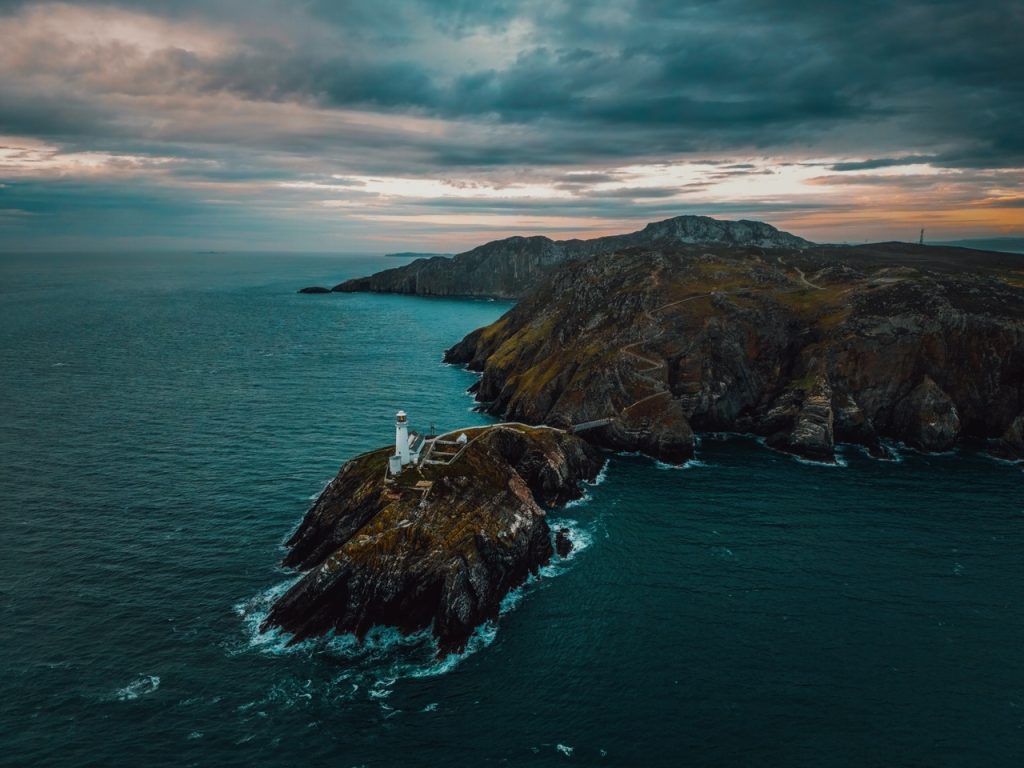Ghosts and spooky tales of the Conwy Valley and North Wales Coast Line!
As it’s that time of year again we thought it would be seasonally spooky to uncover some of the ghostly goings-on you might encounter travelling on the Conwy Valley and North Wales Coast Line.
The towns and villages dotted along the North Wales Coast Line, from Conwy in the east to Holyhead in the west, boast a wealth of history and legends. Along the line you’ll encounter stately castles and grand houses, ancient churches and sacred sites, abandoned industrial landmarks and the relics of civilisations long gone. All of these places are fascinating in their own right, boasting remarkable histories, but they are also tangible connections to a world we can’t see all the time – the other side… the realm of the supernatural.
With all this in mind, you won’t be surprised to learn that North Wales has a reputation for being a hotbed of paranormal activity. Whether you believe in supernatural occurrences or not, tales of morbid murders, excruciating executions and lonely lost souls are stories that appeal to anyone with a love for a good scare at Halloween. Read on if you dare!
Creepy criminals
Beaumaris Gaol – nearest station Bangor
A must-visit on any trip to Anglesey, Beaumaris is a stunning seaside town with a long, fascinating and often turbulent history. Continuously inhabited since the Viking era, Beaumaris boasts a world-famous medieval castle, perfectly-preserved Tudor buildings, gorgeous Georgian houses and an imposing Victorian prison.
Beaumaris Gaol was built in 1829 and housed an array of nefarious and wicked criminals until its closure fifty years later. Although it had a capacity of only 30 inmates, this prison saw its fair share of dastardly goings-on in its short lifetime. Host to not one but two high-profile executions, Beaumaris Gaol was infamous for its brutal treatment of inmates, who were often chained, whipped, made to break rocks and forced to spend days in dark isolation cells. The gaol was also home to one of the last working penal treadmills in Britain, where inmates were made to walk in circles all day long to supply water around the building.
While it is known that several inmates were sentenced to death at Beaumaris, only two executions by hanging actually took place. Both have left tangible marks on the supernatural history of the gaol. The first was William Griffith in 1830, who was sentenced to death for the attempted murder of his ex-wife. On the morning of his execution, he barricaded himself in his cell and had to be forcibly removed and dragged to the gallows. The second was Richard Rowlands in 1862, who was sentenced to death for the killing of his father-in-law. Rowlands maintained his innocence until the end and is said to have put a curse on the nearby church clock from the gallows, foretelling that the four faces of the clock would never show the correct time – to this day, it reportedly does not.
Both men are thought to be buried in the walls of the prison, a fact which may account for some of the otherworldly activity reported around the building. Among the most common are reports of disembodied voices, shadow figures and poltergeist antics.
Some visitors have reported hearing the sound of shuffling feet outside the cells when no one is there and others have reported being touched or hearing disembodied whispers when alone in the cells. Could this be Griffith and Rowlands or other souls lost to the annals of history?
Aside from Griffith and Rowlands, the most commonly-encountered spirit is said to be a former jailer. He has been heard knocking on doors and whistling as if going about his daily checks on the inmates.
Beaumaris Gaol is a popular venue for ghost-hunting events and has even featured on paranormal TV show Most Haunted hosted by Yvette Fielding. If you’re brave enough to explore its shadowy corridors and cells by day – or by night – you might also experience the ‘constant feeling of a dark energy’ experienced by fellow ghosthunters. Go on, we dare you!
Plan your visit: hop on a bus at Bangor for a pleasant trip with great views along the Menai Strait. For entry prices and opening time, visit the goal website here.
Lighthouse Keeper Jack
South Stack – nearest station Holyhead
One of the most famous ghost stories from Anglesey involves the iconic South Stack Lighthouse, located north-west of Holyhead. This lighthouse – world-famous for its precarious position and inaccessibility – has earned a reputation as a supernatural hotspot, with reports of paranormal activity dating back hundreds of years.

Set in an RSPB nature reserve of 90 acres, South Stack is popular with walkers, birdwatchers and photographers. A short bus ride from Holyhead, the lighthouse and nature reserve attract thousands of visitors every year. But you’ll have to earn the right to say you’ve visited! 400 steep steps stand between you and the lighthouse, which is reached by crossing a mini suspension bridge over the churning waters below. After all that adrenalin, you might welcome the sight of a ghost!
The lighthouse, built in 1809, stands 41 metres tall and was constructed to warn ships of the dangerous rocks below. In 1853, a massive storm hit the Anglesey coast, resulting in the wrecking of numerous ships. During the storm, the lighthouse keeper, Jack Jones, was struck by a falling rock. His cries for help went unheard and he died of his injuries three weeks later. Legend has it that the ghost of Jack can still be heard knocking on the lighthouse’s doors and windows at night. Locals claim to have heard heavy footsteps around the lighthouse complex along with blood curdling screams. And if that isn’t enough, others have witnessed doors rattling and have heard tapping on window panes, as if some poor soul is seeking refuge from a ghastly storm.
Yvette Fielding and the Most Haunted crew have also conducted a live TV ghost hunt here and are convinced they encountered the lighthouse keeper. The team claim to have witnessed an apparition watching them through a window but when they gave chase the shadow figure leapt from the cliffs into the sea. Still not convinced? Author Richard Jones, a leading paranormal investigator, gives South Stack Lighthouse a 5 star spooky rating in his latest book, Haunted Britain!
Plan your visit: Part of a larger RSPB nature reserve, South Stack Lighthouse & Cliffs is a great day out for all the family. For opening times and entry prices click here. To book your visit and tour of the lighthouse, click here.
Newry Beach ‘phantoms’
Holyhead – nearest station Holyhead
“Actually that’s quite scary…. especially if seen in the moonlight.”
Another intriguing ghost story from Holyhead involves the eerie figures that appear at Newry Beach, just a few minutes walk from the centre of Holyhead. These figures, which resemble human bodies emerging from the water, have been known to spook passers-by, especially on dark, winter nights.
The sight of these figures has stirred the imagination of many, with some likening them to maritime ghosts or the crew of the mythical ship, the Flying Dutchman. The photo of these ‘ghosts’ has been widely shared on social media, with many commenting on how unique and atmospheric they look. To judge for yourself, click here.
The figures are actually a cluster of old wooden pilings from Holyhead’s former lifeboat ramp, covered in seaweed. Over time, nature has shaped them into humanoid forms, emerging from the water at low tide to frighten passers-by. In reality these ‘phantoms’ are a reminder of the bravery of the Anglesey lifeboat crews who have – and continue to – risk their lives in all weathers to help others.
While these ‘ghosts’ may not be supernatural, they certainly add to the mystique and allure of Holyhead, making the town a fascinating place to visit for those interested in the eerie and uncanny this Halloween.
Plan your visit: from Holyhead train station, Newry Beach is a twenty minute walk through the town centre. Follow signs for Holyhead Maritime Museum and perhaps incorporate a visit to this fascinating museum to learn more about the Welsh men and women who have dedicated their lives to the sea.
The Ghosts of Conwy Valley
The towns and villages along the Conwy Valley Railway Line are rich in history and legends. There are castles and houses dating back hundreds of years; ancient churches, burial grounds and mines that have been part of the land since time immemorial.
It will come as no surprise, then, to learn that North Wales is a hot spot of paranormal activity. Whether or not you believe in things that go bump in the night, stories of menacing monks, pesky poltergeists and sad lost souls are fascinating even if you just love a good yarn.
If you’re taking a trip on the Conwy Valley Railway, here’s a few spine-tingling tales to raise the hairs on the back of your neck!
The ghosts of Gwydir
We start with Gwydir Castle, a fortified medieval manor house on the outskirts of Llanwrst, reputed to be one of the most haunted houses in Wales!
The site of Gwydir has been occupied since the 6th century but it really came into its own in the hands of the Wynn family – powerful Welsh aristocrats who found favour and influence with the Tudor monarchs. It’s now a privately-owned luxury guesthouse and residents and guests alike report many weird and wonderful goings-on!
This is not a new phenomenon, however. Paranormal activity has been recorded in the house since the 19th century, with all accounts consistent in what happens and where it happens.
The ghost of a young servant girl is said to haunt the North Wing. She is accompanied by a repulsive smell of putrefaction and a sudden drop in temperature. To make herself known, she will touch you on the shoulder!
The story goes that Sir John Wynn seduced a serving maid but when she fell pregnant he murdered her and interred her body in a wall. When the house was examined years later, a hollowed out space in the wall was found – exactly where the putrid smell is most potent!
Crying children have been heard in the building when there are no children present, the castle has a resident ghost dog (the current owners dug up a dog’s skeleton in the cellar during renovations) and there are even reports of a torch-lit procession across the lawn.
But, please don’t be put off, Gwydir Castle is a wonderful place to visit. The house and Grade I listed gardens are a magnificent example of Tudor artistry and it occupies a picturesque spot just 3 miles outside Llanrwst. It is open to the public between March and October. Entry is free.
Say ‘boo!’ in Betws
You won’t be surprised to learn that Sir John gets around a bit and his ghostly legacy extends far beyond the walls of Gwydir.
He is said to haunt Swallow Falls, a popular tourist attraction in Betws-y-Coed. Intrepid investigators from the Dark Arts Paranormal team recently did some filming at the waterfall and claim to have footage of a man walking near the falls. They believe it is Sir John Wynn. According to legend, his spirit was trapped here to ‘forever be purged, purified and spat on by the waters for the evil deeds committed by him in his days of nature’.
Not convinced? Judge for yourself and watch the footage.
But Swallow Falls isn’t the only haunted location in Betws-y-Coed.
The Anna Davies countrywear store in the town centre and the adjoining Royal Oak Hotel claim to have experienced ghostly sightings and mischievous poltergeist activity since the 1960s.
A few years ago, the owner of Anna Davies had a shoe thrown at him in the store room, which echoes an incident experienced by his mother-in-law in 1956! Living above the shop, she also witnessed doors slamming, objects moving and items disappearing on a regular basis.
In the Royal Oak Hotel next door, a cloaked lady and a nun have been spotted, TVs turn themselves on and off at will, and numerous ghostly figures are said to haunt the halls. Perhaps they are guests of days-gone-by who had such a good time, they can’t keep away – even in the afterlife!
Creepy Conwy
Conwy Castle, site of bloody battles and cruel subjugation, has a few tales of its own to tell. Before the castle was built Aberconwy Abbey occupied a site nearby. Edward I transferred the monks to Maenan Abbey to make way for his stronghold but it seems a few residents were unwilling to leave. There are reports of two hooded figures, possibly monks, appearing in the castle. They hover motionless, seemingly floating in the air, and have neither feet nor facial features.
Most recently, a disembodied voice has been spooking visitors to the castle. The Dark Arts Paranormal team recorded an EVP (Electronic Voice Phenomenon) of a little girl uttering the words “don’t tell them” – listen for yourself and see if you can make it out.
In the centre of Conwy stands Plas Mawr, a magnificent Elizabethan town house. It was the home of Robert Wynn and his family, wealthy merchants and relatives of the Gwydir Wynns. The story goes that Robert’s pregnant wife, Dorothy, and young son were awaiting his return and that each evening they made the trip to the uppermost tower to see if they could spy their lord returning.
One tragic evening, Dorothy lost her footing on the stairwell and she and her son fell and seriously injured themselves. The household summoned the family doctor but were disconcerted by the arrival of a strange, young doctor who told them his master had been called away urgently. The young doctor quickly realised he was out of his depth; the injuries were far beyond his limited skills. But the household refused to let him leave and locked the young doctor in the room with Dorothy, her unborn child and infant son.
Sadly, the Wynns died and the doctor, in fear of his life, fled into the chimney to hide from the master of the house. When Robert returned he was grief-stricken and vowed to take revenge on the young doctor who had failed him so badly. He searched the house from top to bottom but no trace was found of the doctor. It is thought he hid and perished in the complex network of chimneys that criss-cross Plas Mawr.
Visitors to the house report banging noises from above (the doctor trying to escape his sooty prison?), footsteps, misty faces at the window and a strong smell of tobacco. Enter the Great Hall and Robert Wynn may even greet you with a ghostly “hello”.
Conwy Quay is the site of some strange goings-on too. The Smallest House in Britain smells strongly of salt water and fish when it is opened up in the morning. Unsurprisingly, it was the home of a fisherman – his cheeky spirit’s been known to tease visitors and pull their clothes too.
A few doors down, the Liverpool Arms pub isn’t just home to spirits of the alcoholic variety, but ghostly ones too. It’s haunted by a man with a small child on his shoulders – a former landlord of the pub whose son drowned in the river in the 1930s. A sinister monk is sometimes spotted behind the building; it is believed to signal the death of someone connected to the pub.
If you have any spooky tales of the Conwy Valley, we’d love to hear them. Meanwhile, don’t have nightmares!


